After eating, many people wonder what happens to their blood sugar and why it matters. A normal post meal blood sugar level is usually below 140 mg/dL, while levels above 200 mg/dL may indicate diabetes or other health problems. Keeping track of these numbers can help someone understand how their body reacts to different foods and can be important for those concerned about health risks.
Knowing your post meal blood sugar level is a simple way to watch for signs of diabetes or prediabetes. Factors such as food choices, physical activity, and even stress can affect these numbers. Learning how to measure and respond to changes in blood sugar is helpful for everyone, not just those with diabetes.
Tracking and managing blood sugar is possible with small lifestyle changes. For more details and ways to keep blood sugar in a healthy range, see information on post-meal blood sugar levels.
Key Takeaways
- Post meal blood sugar provides important health information.
- Simple steps can help manage blood sugar after eating.
- Monitoring levels helps spot potential problems early.
Understanding Post Meal Blood Sugar Levels
Blood sugar levels often change after eating, as the body digests food and absorbs glucose. Postprandial glucose readings are helpful for understanding how meals impact energy and health.
What Happens to Blood Sugar After Eating
After a meal, the body breaks down carbohydrates into glucose, which enters the bloodstream. This process causes blood sugar to rise, usually reaching its highest point about one hour after eating.
Insulin is released by the pancreas to help move glucose into the cells, where it can be used for energy. Once glucose is absorbed, blood sugar levels typically start to drop back to normal within two to three hours. Most people will notice their post-meal blood sugar returning close to their pre-meal level by this time.
Sometimes, blood sugar spikes can be larger if a meal contains lots of simple sugars or refined carbohydrates. Over time, frequent high spikes can cause strain on the body and may raise the risk of diabetes or other health problems. Learn more about blood sugar spikes after eating.
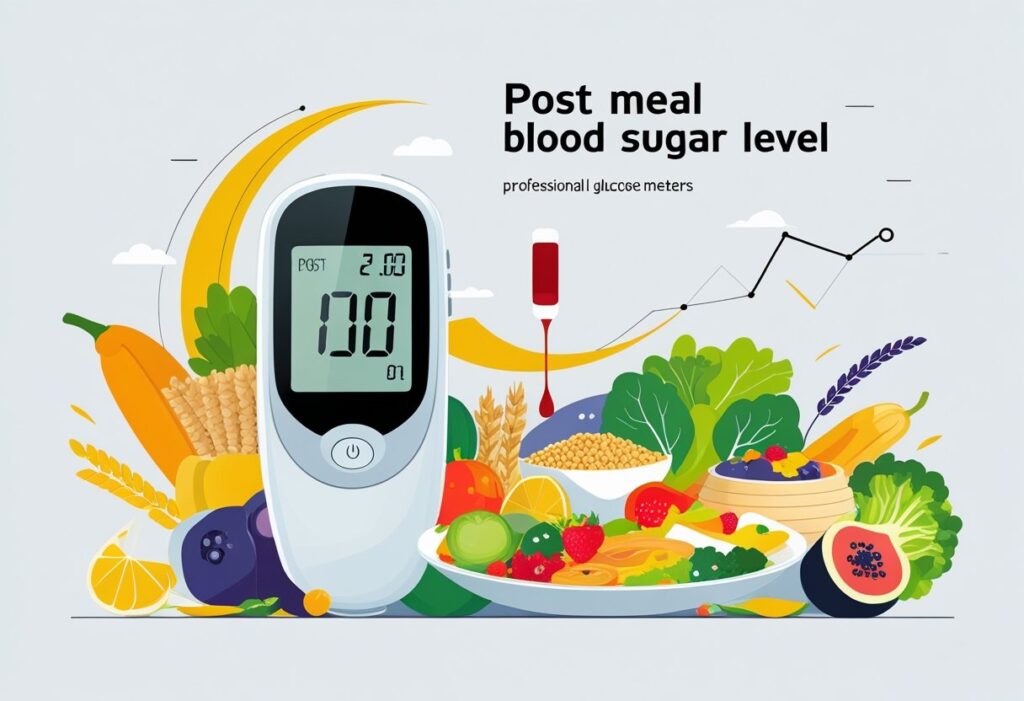
Normal Post-Meal Blood Sugar Ranges
Normal post-meal blood sugar levels can depend on age, health, and specific conditions. For healthy adults, blood sugar two hours after eating is usually less than 140 mg/dL (7.8 mmol/L).
People with diabetes may have different targets. The American Diabetes Association suggests a post-meal target of less than 180 mg/dL (10 mmol/L) for most adults with diabetes.
Typical blood sugar values:
| Time | Normal Range |
|---|---|
| Fasting (before food) | 70-99 mg/dL |
| 2 hours after eating | <140 mg/dL (healthy) |
| 2 hours after eating | <180 mg/dL (diabetes) |
Maintaining normal post-meal blood sugar levels helps protect long-term health and reduces the risk of complications. More details can be found in this guide to healthy post-meal glucose ranges.
Factors Influencing Postprandial Glucose
Many factors affect post-meal blood sugar. The type of carbohydrate in a meal is one of the most important—simple carbohydrates cause faster and higher spikes than complex carbs or those eaten with fiber, protein, or fat.
Physical activity right after eating, such as a light walk, can lower postprandial glucose by helping muscle cells take up glucose for energy. Even a 15-minute walk can significantly reduce blood sugar spikes.
Other influences include:
- Portion size: Larger meals usually cause bigger spikes.
- Insulin sensitivity: People more sensitive to insulin process glucose better.
- Digestive health: Gut function can change how fast blood sugar rises.
- Medications: Some medicines affect how the body manages blood sugar.
Adjusting meal composition, activity, and meal timing can help manage blood sugar after eating. For more tips, visit this post-meal blood sugar guide.
How to Measure Post Meal Blood Sugar
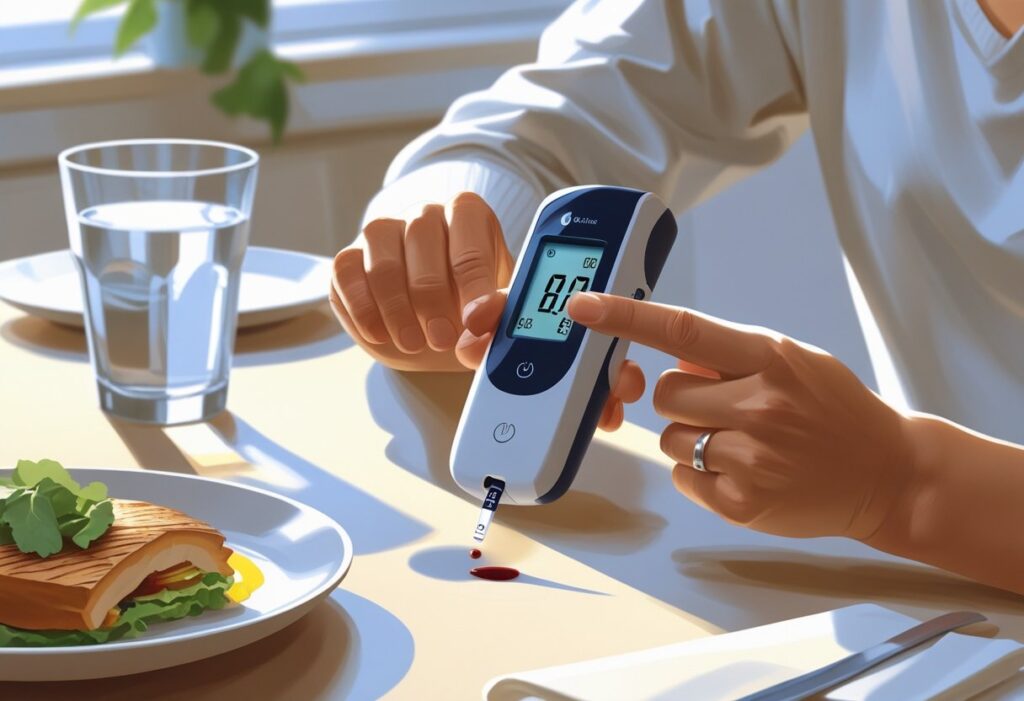
Checking blood sugar after meals helps people see how food affects their body. Using the right tools and timing is important for getting clear results.
Glucose Monitoring Methods
There are a few main ways to check post meal blood sugar. The most common is a blood glucose meter (also called a glucometer). This portable device needs a small drop of blood, usually from the fingertip, and gives results within seconds.
Continuous glucose monitors (CGMs) use a tiny sensor placed under the skin. They measure glucose levels throughout the day and night without pricking fingers for each check. This helps track changes in real time, making patterns easier to see.
An oral glucose tolerance test (OGTT) is sometimes used in medical settings. A person drinks a sweet liquid, then blood is tested at different times. This method is used to diagnose diabetes, not for daily monitoring.
Timing and Interpretation of Measurements
Blood sugar rises after eating, with the highest point, called the postprandial blood sugar peak, usually happening about 1–2 hours later. Experts suggest checking blood sugar 1 to 2 hours after a meal for the best information on post meal effects.
Results are usually interpreted by comparing them to target ranges. For most adults, blood sugar 2 hours after eating should be less than 180 mg/dL, but targets may differ based on health conditions or doctor’s advice. Fasting blood sugar levels, measured before eating, are also key to help spot patterns.
For more facts about ideal checking times and reading results, review advice from organizations like EatingWell and Verywell Health.
Health Implications of Post Meal Blood Sugar Levels
Blood sugar levels after eating play an important role in both short-term wellness and long-term health. Stable numbers lower the chance of developing health conditions like type 2 diabetes, heart disease, and kidney problems.
Short-Term and Long-Term Effects
Right after a meal, blood sugar may rise. If it spikes too high (hyperglycemia), symptoms could include thirst, tiredness, and blurred vision. In rare cases, a person might become confused or very weak.
Over time, repeated high post meal levels increase risks of damage to blood vessels and nerves. Complications like diabetic neuropathy (nerve damage), diabetic nephropathy (kidney disease), and diabetic retinopathy are more likely. Serious problems such as cardiovascular disease, stroke, and heart attack may also occur when blood sugar is not managed well.
Low blood sugar after eating (hypoglycemia) is less common but can still happen, especially in people with diabetes taking medication or insulin.
Diabetes and Prediabetes Risks
Consistently high post meal blood sugar is a signal of prediabetes or diabetes. People with prediabetes or diabetes are at greater risk for nerve and kidney damage and eye disease.
Type 2 diabetes is often diagnosed when blood sugar levels after meals remain above recommended ranges, even before fasting levels rise. Type 1 diabetes and gestational diabetes may also show high post meal levels, but the causes and treatments are different for each type.
Managing blood sugar after meals with healthy food choices and regular exercise can help lower these risks. Monitoring and understanding post meal levels is a key step in preventing diabetes-related complications.
Managing and Controlling Post Meal Blood Sugar
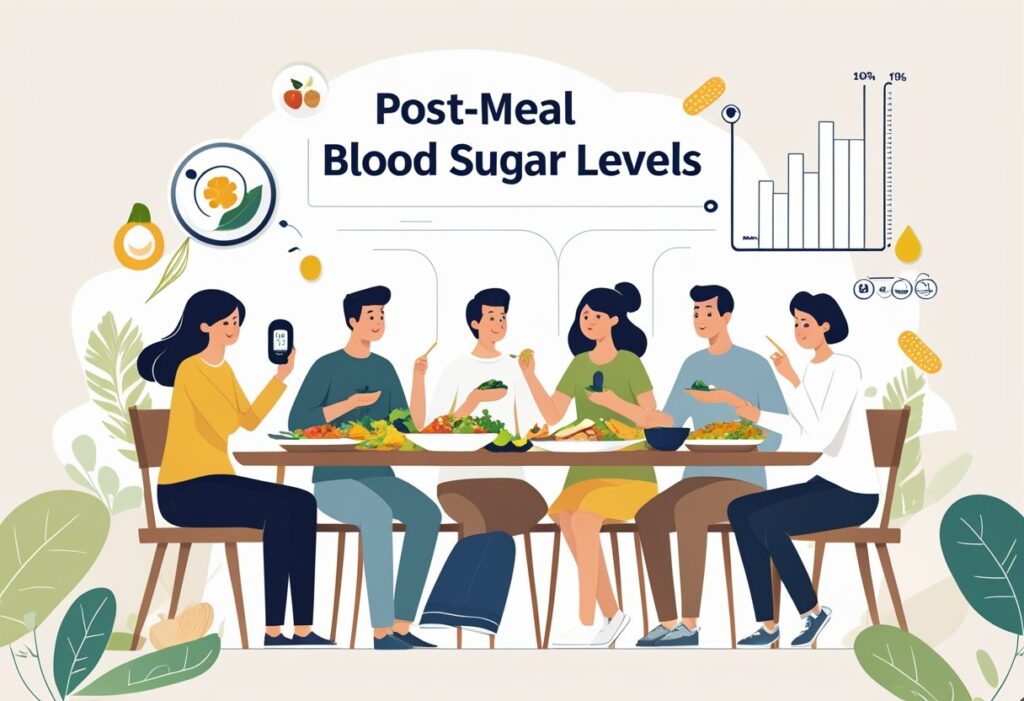
Managing post meal blood sugar relies on the foods chosen, how much is eaten, and activity levels during the day. Specific lifestyle modifications related to diet and exercise play a crucial role in maintaining normal blood sugar.
Balanced Meals and Meal Composition
A balanced meal contains carbohydrates, protein, and healthy fats. This mix slows digestion, which leads to more stable blood sugar after eating. Including vegetables, lean protein, and a small serving of healthy fats, such as olive oil or avocado, can help prevent rapid spikes.
Using the plate method can make meal planning easier:
| Food Group | Plate Portion |
|---|---|
| Non-starchy Veggies | ½ of the plate |
| Lean Protein | ¼ of the plate |
| Whole Grains/Starch | ¼ of the plate |
Eating a variety of foods encourages better nutrient intake and supports stable blood sugar. Limiting high-sugar drinks and processed snacks is also important. For more information about meal balance, see tips for controlling post meal blood sugar levels.
Role of Carbohydrates and Fiber
Carbohydrates impact blood sugar more than any other nutrient. Choosing complex carbohydrates like whole grains, beans, and vegetables can help slow the rise in blood sugar levels. Foods with a low glycemic index (GI) digest more slowly, leading to a steadier blood sugar response.
Fiber, especially soluble fiber, is key. It slows the absorption of sugars in the digestive system. High-fiber foods include oats, lentils, fruits, vegetables, and seeds.
Try to replace white bread or rice with whole grain versions. Adding beans or vegetables to meals can further boost fiber intake. Learn more about reducing spikes by managing carbs and fiber from DiaTribe’s guide.
Importance of Portion Control
Portion size is a major factor in blood sugar management. Eating too much, even of healthy foods, can cause post meal blood sugar to go up higher than desired. Using measuring cups, food scales, or visual guides like the plate method can help keep portions in check.
Some people find success using small plates or bowls to avoid overeating. Checking the serving sizes on food labels can also support better portion control. For complex carbohydrates and whole grains, start with ½ cup cooked as a serving. More strategies can be found at Andy The RD’s guide.
Monitoring how much is eaten and stopping when full can help support both weight management and blood sugar stability. Consistent portion control helps the body maintain normal blood sugar after eating.
Physical Activity and Exercise
Physical activity helps lower post meal blood sugar by using glucose for energy. Even a short walk, about 10-20 minutes after eating, can make a difference. Regular activity, such as walking, cycling, or swimming, increases how sensitive the body is to insulin.
Exercise routines do not have to be intense. Moderate movement after meals is effective for most people. For those with health concerns, it’s important to discuss exercise plans with a doctor.
Higher activity levels are linked to better blood sugar management and weight control. To see more on how activity impacts blood sugar, visit WebMD’s strategies.
Additional Considerations in Post Meal Blood Sugar Management
Managing blood sugar after meals involves more than food choices. Medications, insulin sensitivity, stress, and individual health differences all affect blood glucose control.
Pharmaceutical Impacts on Insulin Sensitivity
Medications play an important role in post meal blood sugar management. People with diabetes may take insulin or oral medicines to help control spikes after eating. These medicines work in different ways, such as helping the body release more insulin or making cells more sensitive to insulin.
Insulin resistance means the body does not respond to insulin as well. This causes higher post meal glucose levels and may require changes in treatment. Insulin sensitivity can also change based on activity, illness, or diet.
Adjusting medication timing or doses might be needed for better after-meal blood sugar management. It’s important to follow the treatment plan and discuss any changes with a healthcare provider before making adjustments.
Individual Factors and Stress Management
Post meal blood sugar can be different from person to person. Factors include age, weight, physical activity, and hormone levels. These individual differences affect how the body responds to food and medication.
Stress is another key factor. When a person is stressed, the body releases hormones like cortisol, which can raise blood sugar. Practicing stress management techniques, such as deep breathing, gentle exercise, or mindfulness, can help lower stress and improve blood glucose control.
Healthy lifestyle habits:
- Regular physical activity
- Adequate sleep
- Mindful eating
help support better outcomes and make blood sugar more predictable.
Consulting Healthcare Providers
Working with a healthcare provider is essential for safe and effective management. Providers offer advice on medication choices, blood glucose testing, and proper timing for postprandial checks.
A healthcare professional can help find patterns in blood sugar levels, suggest medication adjustments, and recommend diet or lifestyle changes. Regular check-ins allow for personalized care, helping address issues such as rising or unpredictable post meal blood sugars.
Following guidelines from organizations like the American Diabetes Association ensures best practices and safer long-term health. Frequent communication and honest reporting of challenges support better management and improve overall health.
Frequently Asked Questions
Blood sugar levels after eating change depending on the amount of food, type of food, and whether a person has diabetes. Levels rise after a meal, peak at a certain point, and then decrease over the next few hours.
What is considered a normal blood sugar level two hours after eating?
A normal blood sugar level two hours after eating is usually less than 140 mg/dL for adults without diabetes. This level helps show that the body is processing glucose from the meal as expected. For more details about normal ranges, see this guide to healthy post-meal blood sugar levels.
How do blood sugar levels differ for diabetics versus non-diabetics postprandially?
People with diabetes often have blood sugar levels that stay higher for longer after eating. Non-diabetics usually see a rise followed by a return to normal within two hours. Diabetics may see levels over 180 mg/dL, while healthy adults tend to stay below that number after eating. More information can be found in this article on blood sugar after eating.
What should I expect my blood sugar to be one hour after consuming a meal?
Blood sugar levels usually peak about one hour after a meal. For most non-diabetics, this peak is often below 180 mg/dL. However, people with diabetes may see higher spikes at this time. Levels usually start to drop after this point as the body uses or stores the extra glucose. Details on this process are covered in this resource.
What blood sugar level is considered dangerous shortly after eating?
Blood sugar readings of 200 mg/dL or higher soon after a meal are considered high and may be dangerous, especially for those with diabetes. These elevated levels can lead to short-term symptoms and long-term health risks if they happen often. Levels above this range can indicate diabetes or a need for better management.
At what point post-meal does blood sugar typically peak?
For most people, blood sugar will peak between 30 and 60 minutes after eating. This timing can shift based on the type of food eaten and individual metabolism. Highly processed or sugary foods may cause a faster and higher spike.
How does blood sugar change three hours after a meal?
About three hours after eating, blood sugar levels in healthy individuals usually return to pre-meal levels or close to them. The body has typically used or stored much of the glucose by this point. People with diabetes or problems with insulin may still have higher blood sugar at this time than before eating.
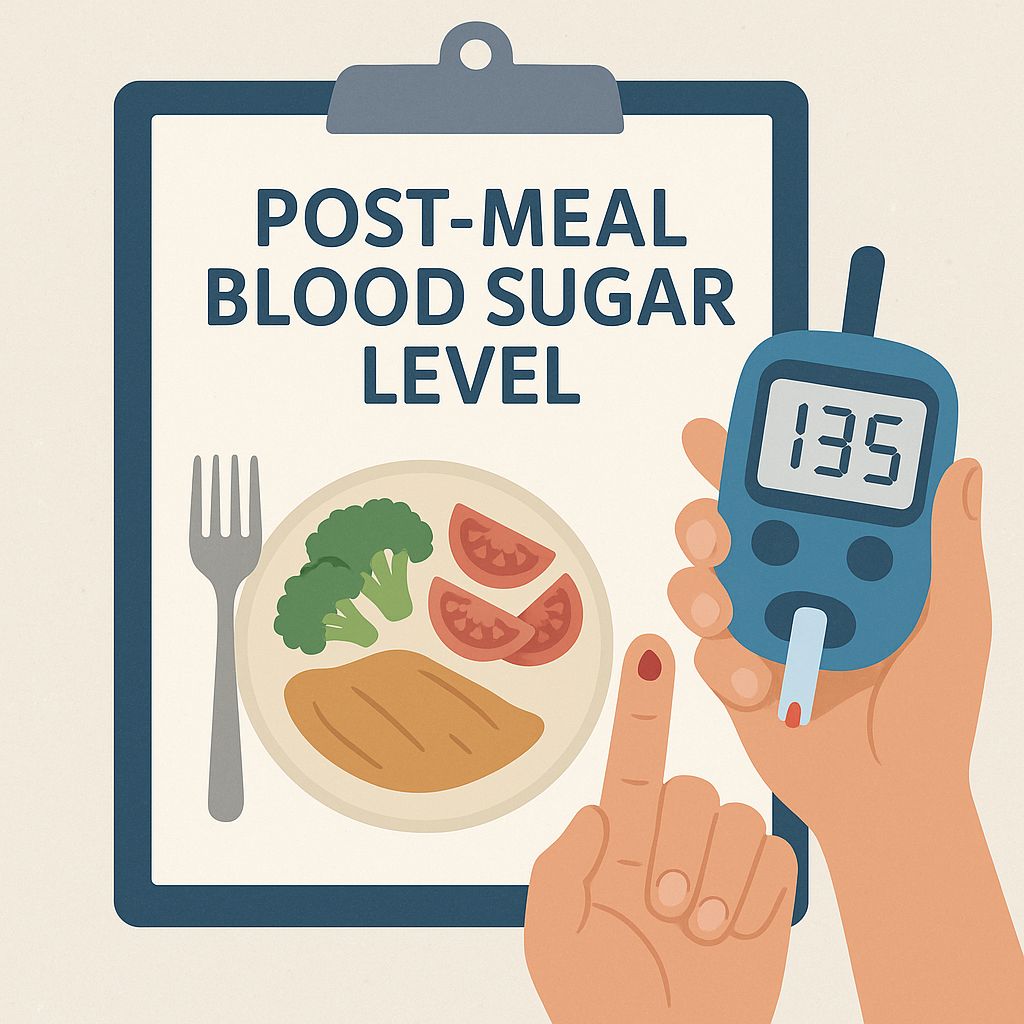
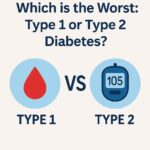


Pingback: Control Blood Sugar Levels at Home with Natural Remedies: Complete Guide - Pharma Heals
Pingback: Diabetes Test Kit Guide for Accurate Home Monitoring - Pharma Heals
Pingback: Can People With Tattoos Donate Blood? Rules, Facts, and Eligibility - Pharma Heals
Pingback: Diabetes 2 Blood Glucose Levels: Ranges, Monitoring & Control - Pharma Heals